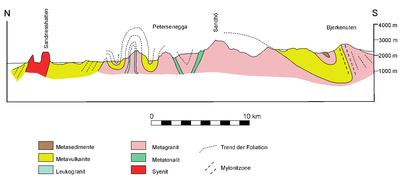Conrad Mountains
| Conrad Mountains | ||
|---|---|---|
|
View from the Dallmann Mountains to the west over the Glopeken to the northern part of the Conrad Mountains |
||
| Highest peak | Sandeggtind ( 3055 m ) | |
| location | Queen Maud Land , East Antarctica | |
| part of | Orvinfjella | |
|
|
||
| Coordinates | 71 ° 50 ′ S , 9 ° 45 ′ E | |

The Conrad Mountains in Dronning Maud Land protrude over a length of 36 kilometers from the inland ice of the Antarctic . It extends in a north-south direction a good 200 km south of the Princess Astrid coast . It is an average of five and a maximum of ten kilometers wide. In January 1939 the mountains were discovered during flights of the German Antarctic Expedition 1938/39 and documented with aerial photographs . The mountain range was named after Fritz Conrad , the head of the nautical and scientific department of the naval management and head of the naval weather service during World War II .
Since most of the aerial photos were lost in the Second World War, the mountains were photographed again during the Norwegian Antarctic Expedition 1956–1960 and control points on the ground were also measured for more precise orientation . The Norsk Polarinstitutt used these aerial photographs to create a map series on a scale of 1: 250,000, on which the mountain range is named Conradfjella . The first geological research took place as part of the 4th Soviet Antarctic Expedition 1958-1960. Systematic geological mapping and exploration was continued by the GeoMaud expedition in 1995–1996 .
geography
The mountain range consists of an elongated rock ridge in a north-south direction, which at its widest point has an east-west extension of 5 kilometers. In the north, the mountain range dissolves into a series of individual nunataks , which are separated from each other by glaciated areas. Approximately in the middle of the mountain range lies the Sandeggtind , the highest elevation of the mountain with 3055 m . Other prominent peaks are the 2840 m high Bjerkenuten at the southern end of the mountain, the Sandhø with 2664 m and at the northern end of the Sandneshatten with 2200 m . On its west side the mountains are bordered by a moraine belt up to 4 km wide . From neighboring mountains in the west and east, the mountains are bounded by wide glaciers . The Sandeken the west separates the Conrad Mountains from Short Mountain , east of the Glopeken forms the border with the Dallmannbergen . Both glaciers unite on the northern foreland of the mountains and flow out onto the Lazarev Ice Shelf .
geology
The mountain range consists of highly metamorphic , multiply folded gneisses and amphibolites , the parent rocks of which are volcanic rocks and granites of an island arc with a Mesoproterozoic age. At the turn of the Mesoproterozoic / Neoproterozoic , these rocks were deformed and metamorphically overprinted for the first time when the arch of the island collided with the Kaapvaal-Grunehogna craton . Melts with a granitic and tonal composition penetrated and solidified in the form of thin corridors. The rocks underwent a further deformation when the West and East Gondwana collided approx. 540 mya ago , which resulted in today's east-west oriented fold structure . Individual folds are exposed in the almost vertical walls of the mountains. At the northern end there is a Syenite massif with a diameter of about 2 km, which penetrated and solidified there after folding. The mountains have been subject to erosion since the Ordovician .
literature
- Karsten Brunk: Cartographic work and German naming in Neuschwabenland, Antarctica . (pdf) In: German Geodetic Commission, Series E: History and Development of Geodesy . 24 / I, 1986, pp. 1-42. Retrieved April 19, 2009.
- Norsk Polarinstitutt (ed.): Blad L5 Humboldtfjella (topographic map 1: 250,000) . Oslo 1968.
- Hans-Jürgen Paech (Ed.): International GeoMaud Expedition of the BGR to Central Dronning Maud Land in 1995/96 - Volume I: Geological Results . Schweizerbart, Stuttgart 2004, ISBN 978-3-510-95923-5 , p. 1-499 .
- Alfred Ritscher: Scientific and aeronautical results of the German Antarctic Expedition 1938/39 . Koehler & Amelang, Leipzig 1942, p. 1-304 .
Web links
- Geographical names in the area of the GEOMAUD expedition (PDF; 215 kB) accessed on May 12, 2010
- Data sheet. Australian Antarctic Division; Retrieved July 7, 2010
- Geographical names of the Antarctic. Standing Committee on Geographical Names ; accessed on October 17, 2016
Individual evidence
- ↑ View of the Conrad Mountains from the south, oblique aerial photo from Bildflug V, January 1939 (PDF; 763 kB), accessed on August 31, 2012
- ↑ Genesis of Ferropotassic A-Type Granitoids of Mühlig-Hofmannfjella, Central Dronning Maud Land, East Antarctica . (PDF; 2.38 MB) accessed on August 31, 2012


